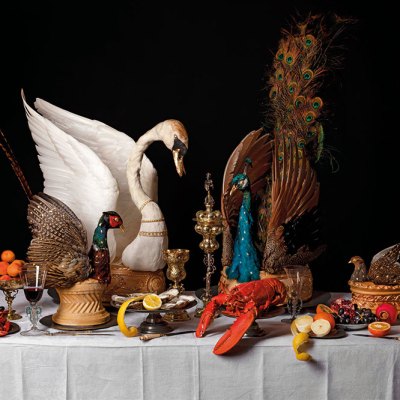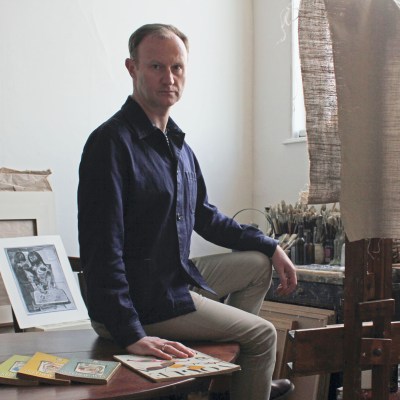Elizabeth David’s A Book of Mediterranean Food was published by John Lehmann in 1950, an unpromising year for anything that suggested extravagance or fine living. To a Britain still in the grip of post-war austerity and rationing David’s book evoked a seemingly lost world of European travel, where dishes made from plentiful fresh ingredients ripened in the sun were served out of doors under cloudless blue skies. Indeed, part of David’s aim, like that of Cyril Connolly in The Unquiet Grave (1944), was ‘to stir memories’ of life in southern Europe when the going was good, and so Lehmann decided that the book needed to be designed ‘as attractively and unausterely as possible’. He therefore sent David’s ‘unprepossessing bundle of grubby typescript’ to John Minton, giving the painter carte blanche to come up with a dust jacket and illustrations.
Minton had already contributed vignettes to Doris Lytton Toye’s monthly cookery column in Vogue, a job previously undertaken by Denton Welch in between bouts of ill health resulting from the catastrophic road accident which eventually led to his death in 1948 aged only 33. A collection of the recipes was published in 1947 as Vogue’s Contemporary Cookery, but the illustrations of both artists were so reduced in scale, and the quality of the paper so poor, that they fatally lost definition. Minton fared much better with Lehmann, for whom he had already provided covers for the hugely popular Penguin New Writing (1940–50) and several striking dust jackets, notably one for Ernest Frost’s The Dark Peninsula, a now forgotten novel set during the Italian campaign. Minton’s design wittily featured a knocked-over glass, from which red wine spread across a wooden table to form the geographical outline of Italy.
Another precursor to A Book of Mediterranean Food was the travel book for which Lehmann had despatched Minton and the young poet Alan Ross to Corsica in the summer of 1947. Time Was Away had been conceived by Lehmann as ‘an extremely lavish, anti-austerity production’, and Minton supplied ‘an evocatively sultry and arcadian jacket’ in green, blue and yellow, along with eight coloured lithographs and a large number of line drawings that brilliantly captured the bright dazzle and deep shadows of the island. Ross later observed that it was in the oppressive Corsican heat that Minton had developed his mature style as an illustrator, an ‘angular, bony draughtsmanship, reflective of his own physique’.
Minton had gone on to produce a series of spectacularly colourful oil paintings of Corsica on his return to London, exhibiting them at the Lefevre Gallery in 1949. Many of them depicted fruit and fish and other ingredients for Mediterranean cuisine, and so confirmed Minton as the obvious choice for the David commission. Handsome men also featured strongly, and Minton claimed that the drawings he was making for the cookery book were ‘mostly of sailor boys, which is going to disconcert the eager housewife’. In fact only one sailor appeared in the finished book, raising a glass to a young woman in the superbly designed frontispiece. The two figures are framed by an arch through which an outdoor restaurant and a harbour can be glimpsed, while an inspiring heap of ingredients occupy the foreground. Signs of plenty are similarly to the fore in the wrap-around image on the jacket, which makes skilful use of a limited palette of blue, green, yellow and red. David delightedly recalled that: ‘In the shop windows [Minton’s] brilliant blue Mediterranean bay, his tables spread with white cloths and bright fruit, bowls of pasta and rice, a lobster, pitchers and jugs and bottles of wine, could be seen far down the street.’
Variations on these two images were used for the double-page spread on which the title appeared in David’s second book, French Country Cooking (1951), while the wrap-around image on the dust jacket depicted the interior of a well-stocked kitchen, many of its utensils borrowed from the author to ensure accurate representation. As with the earlier book, each chapter was prefaced by a marvellously detailed full-page line drawing, often showing heavily laden tables beyond which windows opened out on to landscapes, providing a pleasing depth of perspective and nicely tying the ingredients to the land that produced them. The perfect match of author and illustrator meant it barely mattered that most of the recipes’ ingredients were unavailable in Britain at the time, and the two volumes remain a landmark in the history of English cookery books.
From the April 2020 issue of Apollo. Preview and subscribe here.


